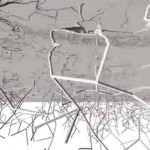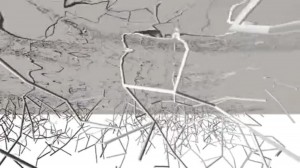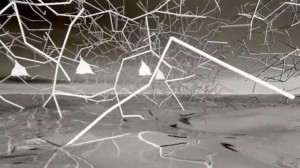SALT
reformative interventions in the Llobregat delta
Location
At the new mouth of the Llobregat river
Application and Flow Domain
River basins flow medium: Water
Tree channels – Low Resistivity : Low-resistance rivulet and rivers
Interstitial spaces – High Resistivity : Darcy flow through porous media
Formation
Port entry points
Mineral Exoskeleton
Flow of matter-energy gradients
Buoy system (mediator between subterra and superterra)
3-Step Program
1. POWER SOURCE:
Using the Llobregat rivers outlet juncture, energy is harvested through catalysing the natural difference from incoming fresh water to outcoming salt water in their ion densities by using a single low-power charge. The result is a magnification of this energy at 74 percent effiecency.
Any additional power is diverted towards docked ships with diesel-electric transmissions or hybrid electric naval vehicles through the means of a system of rechargeable battery hubs. The installation serves as an ideal recharge point as it is enroute to the dock for ships coming in from the eastern coasts of North Africa as well as incoming ships from the Canary Islands and Gibraltar.
“The battery itself is simple, consisting of two electrodes – one positive, one negative – immersed in a liquid containing electrically charged particles, or ions. In water, the ions are sodium and chlorine, the components of ordinary table salt.
Initially, the battery is filled with freshwater and a small electric current is applied to charge it up. The freshwater is then drained and replaced with seawater. Because seawater is salty, containing 60 to 100 times more ions than freshwater, it increases the electrical potential, or voltage, between the two electrodes. That makes it possible to reap far more electricity than the amount used to charge the battery.”
research report from Yu Cui and research team, Stanford University
2. WATER TREATMENT:
Harvested energy is used to power an auxillary desalination plant acting as support for the already functioning desalination plant built in 2009 and located at the mouth of Llobregat river. The need is dire, as in 2008 Spain faced one of its driest years on record, forcing Barcelona to import drinking water by tanker.
The Barcelona desalination plant is located in the municipality of El Prat del Llobregat, Barcelona. With a drinking water output of 200,000m³/day, it is the largest reverse osmosis-based desalination plant in Europe. It was awarded the “Desalination Plant of the Year” award by the Global Water Awards 2010.
The plant was built by Aguas Ter Llobregat (ATLL), the public utility that is responsible for the supply of water to the city of Barcelona and the surrounding eight districts. It was intended to increase the water security and availability in the Barcelona metropolitan region. The plant was officially inaugurated in July 2009. It is currently supplying drinking water to about 1.3m inhabitants in the region, catering to almost 20% of the population.
In addition to the main desalination plant in El Prat del Llobregat two more desalination plants are being built in the region of Catalunya.
3. DISTILLATION/CONSTRUCTION:
The desalination process produces both drinking water and extracted salt in a one-cycle distilling process. The salt is then immediately transported through a branched system of aluminum pipes to specific nodes. These nodes are coordinated through a sensor network which detects the required degrees of salinity in each of the construction basins. It is in this process that the fundamental aspect of construction will occur, as salt will be the primary medium in a controlled diffusion-limited aggregation of material. The basins serve as the foundation points in the construction process, therefore by ‘injecting’ salt into these basins it is possible to control their individual salinity levels and increasing/decreasing their respective permille (parts per thousand) (%x), where x is approximately the grams of salt per kilogram of solution. Finally, the addition of supplemental ingrediants such as bluing solution as well as small traces of ammonia will accelerate the growth process achieving as much as a 10x construction speed.
These seemingly esoteric approaches to measuring and reporting salt concentrations may appear to obscure their practical use, but it must be remembered that salinity is the sum weight of many different elements within a given volume of water. It has always been the case that to get a precise salinity as a concentration and convert this to an amount of substance (sodium chloride, for instance) required knowing much more about the sample and the measurement than just the weight of the solids upon evaporation (one method of determining salinity). For example, volume is influenced by water temperature; and also the composition of the salts is not a constant (although generally very much the same throughout the world ocean). Saline waters from inland seas can have a composition that differs from that of the ocean. For the latter reason, these waters are termed saline as differentiated from ocean waters.
Ode to Salt Series 3.2012
‘Ode to Salt’ is a series of films with focus on remedying the Llobregat delta’s delicate eco-system and symbiotic relationship with the port of Barcelona through a milieu of reformative interventions. The title is inspired by the Chilean poet Pablo Neruda’s poem ‘Ode to Salt’, and is derived from salt as a tangible yet ethereal and elastic medium through which the emergence of large urban structures out at sea may manifest.
However, note the following film is a narrative-driven segment with an atmospheric quality. It is not meant as a concrete realisation of physicality but rather as a demonstration of the forces at play and the underlying potentials existing within the site.
To view the finished film, please click on the head title ‘Ode to Salt Series 3.2012′, or copy and paste the link just below.
https://vimeo.com/38863904
excerpts;
author : Seif El-Din Mansour Shawky
tutor : Willy Muller assisted by Maite Bravo
MAA 2011/12






























